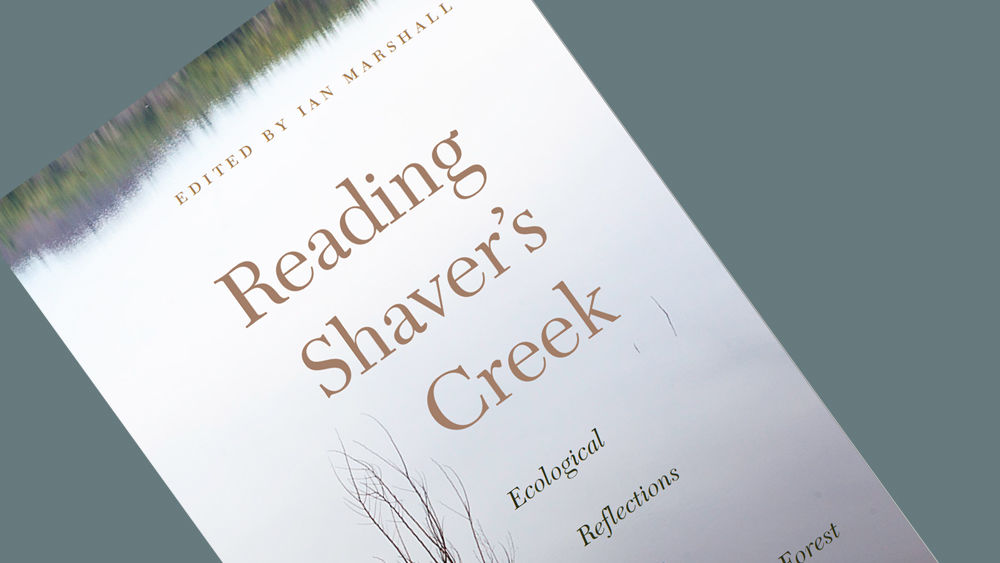
ALTOONA, Pa. — With the advent of spring comes the desire to get outside, into nature. Central Pennsylvania has many places — state and national forests and parks, hiking trails, and rivers — for recreation. One of the best places is Shaver’s Creek Environmental Center, part of Penn State’s 7,000-acre Stone Valley Experimental Forest. And the perfect introduction for those not familiar with Shaver’s Creek — as well as for those who want to know it better — is the new book "Reading Shaver’s Creek: Ecological Reflections from an Appalachian Forest," edited by Ian Marshall, professor of English and environmental studies at Penn State Altoona.
The seeds for this book were planted more than a decade ago. In 2005 Marshall attended a conference that included a presentation by faculty from Oregon State University on their work in the H. J. Andrews Experimental Forest, a research program within the Long-Term Ecological Research Network. While environmental studies and research go hand in hand, too often humanities are not even considered. Oregon State, however, created the Spring Creek Project to bring writers, artists and philosophers into the experimental forest to visit designated sites and share their experiences in the Andrews Forest Long-Term Ecological Reflections Project.
“I thought, ‘Wow, what a cool idea,’” said Marshall of the Oregon State project. That got him thinking about the possibility of a similar project at Penn State. He knew exactly where he wanted it to be.
“As part of my son’s home schooling I would take him out to Shaver’s Creek to work as a volunteer, and I would take a hike,” Marshall said.
Marshall shared the concept of an ecological reflections project with Shaver’s Creek Director Mark McLaughlin, who agreed it was a good idea.
The first step involved selecting sites, which Marshall scouted during his weekly hikes.
“I would start to pick spots that we would have writers come to — eight spots,” Marshall said.
Each now has a name.
“One is the Raptor Center. One is the site of an old sawmill being reclaimed by the forest. Another spot is in the Stone Valley Experimental Forest — the Chestnut Orchard. Another spot is just a really cool spot along the stream, a striking piece of landscape, the Dark Cliffy Spot,” said Marshall. Another one is along the Bluebird Trail. And one is “Lake Perez, named for the person who had the idea of putting the dam in.”
Once the sites were selected, artists were invited to visit Shaver’s Creek and record their thoughts, whether it be through written word, music, or some other art form. From long-published professionals to Shaver’s Creek volunteers, over the past 10 years people have visited the sites and shared their experiences through their art, which can be found on the Shaver’s Creek website.
Among the contributors to the "Reading Shaver’s Creek" volume are Pulitzer Prize-nominated writer Scott Weidensaul; naturalist Marcia Bonta; nature writers David Gessner, Mike Branch and Katie Fallon; nature poets John Lane and David Taylor; Shaver’s Creek interns Jacy Marshall-McKelvey and Hannah Inglesby; and from Penn State Altoona, Carolyn Mahan, professor of biology and environmental studies; Todd Davis, professor of English and environmental studies; and of course Marshall himself.
“The book collection is the ‘best of’ from the first 10 years,” Marshall said. “The idea is we’re going to do this for 100 years. We’re going to see not just how the landscape changes over time but also how writers from different backgrounds see the same place in different ways.”
The project wouldn’t exist without Shaver’s Creek and Marshall is grateful for the support of the Environmental Center’s personnel, including naturalist and program director Doug Wentzel; educational operations manager Joshua Potter, the son of Corky Potter, who started Shaver’s Creek in 1976; and assistant marketing director Justin Raymond. “They make the arrangements with the visiting writers. They take care of all the details and they’ve been wonderful supporters.”
Shaver’s Creek is currently undergoing its first major facility upgrades, including the addition of two classrooms and improvements to the Discovery Room and bookstore. See ShaversCreek.org to learn more.



